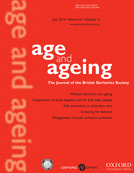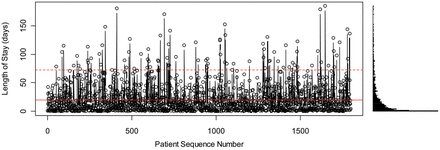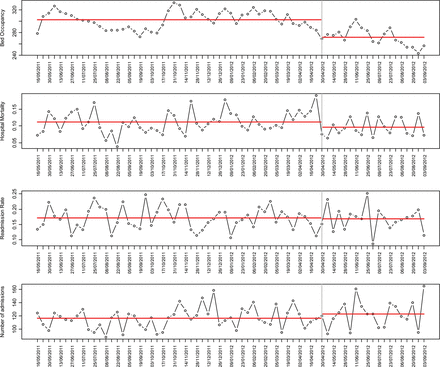-
PDF
- Split View
-
Views
-
Cite
Cite
Kate M. Silvester, Mohammed A. Mohammed, Paul Harriman, Anna Girolami, Tom W. Downes, Timely care for frail older people referred to hospital improves efficiency and reduces mortality without the need for extra resources, Age and Ageing, Volume 43, Issue 4, July 2014, Pages 472–477, https://doi.org/10.1093/ageing/aft170
Close - Share Icon Share
Abstract
Background: hospitals are under pressure to reduce waiting times and costs. One strategy that may be effective focuses on optimising the flow of emergency patients.
Objective: we undertook a patient flow analysis of older emergency patients to identify and address delays in ensuring timely care, without additional resources.
Design: prospective systems redesign study over 2 years.
Setting: the Geriatric Medicine Directorate in an acute hospital (Sheffield Teaching Hospitals NHS Foundation Trust) with 1920 beds.
Subjects: older patients admitted as emergencies.
Methods: diagnostic patient flow analysis followed by a series of Plan Do Study Act cycles to test and implement changes by a multidisciplinary team using time series run charts.
Results: 60% of patients aged 75+ years arrived in the Emergency Department during office hours, but two-thirds of the admissions to GM wards were outside office hours highlighting a major delay. Three changes were undertaken to address this, Discharge to Assess, Seven Day Working and the establishment of a Frailty Unit. Average bed occupancy fell by 20.4 beds (95% confidence interval (CI) −39.6 to −1.2, P = 0.037) for similar demand. The risk of hospital mortality also fell by 2.25% (before 11.4% (95% CI 10.4–12.4%), after 9.15% (95% CI 7.6–10.7%) which equates to a number needed to treat of 45 and a 19.7% reduction in relative risk of mortality. The risk of re-admission remained unchanged.
Conclusion: redesigning the system of care for older emergency patients led to reductions in bed occupancy and mortality without affecting re-admission rates or requiring additional resources.
Introduction
Hospitals are under pressure to reduce waiting times and costs [1]. One strategy to reducing costs focuses on patient flow by reducing the length of stay (LoS) of patients and consequently reducing hospital beds via increased throughput [2]. Hospital beds in the National Health Service (NHS) are used for planned elective admissions and unplanned emergency admission. Emergency admissions, which account for less than half (45%) the admissions, consume 70% of hospital bed days [2], half of which may potentially be inappropriate because the patient is already fit for discharge or would be better placed elsewhere (e.g. home, nursing home) [2]. Furthermore, Allder et al. [3] report that unnecessary delay in the clinical decision making process also prolongs hospital stay. Unnecessarily prolonged stay in hospital compromises patient safety, increases costs and increases congestion whilst increasing stress on staff and systems [4–6].
We undertook a patient flow analysis focusing on older emergency patients admitted to the Geriatric Medicine (GM) Directorate of our hospital (Sheffield Teaching Hospitals NHS Foundation Trust with 1920 beds) to identify and address delays to ensuring timely care without adversely affecting the risk of mortality and/or re-admission within existing resources.
Method
We formed a multidisciplinary team which included consultant geriatricians, junior doctors, nurses, pharmacists, therapists and clerical staff with expert clinical systems engineers as the facilitators. The team used a combination of the Institute for Healthcare Improvement's Model for Improvement, Toyota's Lean methodology and statistical process control (SPC) [7]. We met weekly for ∼1 h over a 2-year period.
Patient flow analysis
We began with analyses of routinely collected attendance and admissions data for the year 1/4/2009 to 31/3/2010 to understand the profile of attendance (numbers, age band and time of day) to our Emergency Department (ED) and the subsequent profile of admissions into the GM speciality. We also looked at the LoS of consecutive admissions to GM wards over sequential 3-month periods to understand the pattern and variation in LoS. This work was further supported by a semi-implicit [8] case-note review of GM patients who were purposefully sampled because of their excessively long LoS. This allowed us to understand the reasons behind their excessively long LoS and to compare the date that the patient was ready for discharge (as recorded by their consultant) against the actual date of discharge (see Supplementary data, available at Age and Ageing online, Appendix S9).
Plan Do Study Act cycles
We under took a series of tests of change to see if we could improve flow by reducing delays in decision making and discharge for GM patients. For each test, a small-scale Plan Do Study Act (PDSA) cycle was performed and, if this proved successful, the test was tried more widely. For example, the change to consultant working practices was initially tested by one consultant for 1 day, next by three consultants for 3 days and then by the eight consultants for 1 week before being universally adopted by the department.
Outcome measures
We posited that if our changes were successful, they would result in a fall in bed occupancy without resulting in increased mortality and/or increased re-admissions. So our outcome measures are average bed occupancy, in-hospital mortality and the 28-day readmission rate, which were obtained from routinely collected data over 69 consecutive weeks from 6 March 2011 to 9 September 2012. These were monitored in near real time by the team using run charts and SPC charts (see Supplementary data, available at Age and Ageing online, Appendix S3).
Statistical analyses
We used time-series designs and plotted the outcome measures over time using run charts with medians pre- and post-intervention [9]. Observing the data over time allowed us to monitor whether improvement in the outcome measures was sustained.
Real-time run and SPC charts were subjected to further statistical analyses. These began with the portmanteau test to see if our outcomes were consistent with white noise [10] (i.e. were not auto-correlated) and then proceeded to the use of regression models with the outcome as the response variable and time (weeks 1–69) as a continuous covariate with a binary covariate (0/1) reflecting the pre- and post-intervention period which was switched on in Week 51 (30 April 2012). Despite the complex nature of the flow system and the intervention [11], statistical significance was defined at the 5% level (P ≤ 0.05). For average bed occupancy we used a Prais–Winsten regression model because it corrects for first-order serially correlated residuals [12]. For mortality and re-admissions, we used logistic models for grouped data (as there was no evidence of serial auto-correlation in these outcomes). Analyses were carried out using STATA version 12.0 [13] and R [14] (see Supplementary data, available at Age and Ageing online, Appendix S2).
Ethical considerations
Application of the Healthcare Quality Improvement Partnership Simple Rules Toolkit [15] confirmed this work as service review with no requirement for ethical review.
Results
Patient flow analysis
For the period 1/4/2009 to 31/3/2010, there were 98,702 attendances to the ED of which over half (54.5%, 53,801/98,702) were between 0800 and 1700 h. Of the total attendees, 17.2% (16,953/98,702) were aged 75+ years and in this subgroup 60.4% (10,246/16,953) arrived between 0800 and 1700 h. These attendances resulted in 6766 admissions into GM wards, but of these only 36.3% (2453/6766) were admitted between 0800 and 1700 h. So, whilst 60% of the demand from older patients (aged 75+ years) arrives in A&E during office hours, two-thirds (63.7% 4313/6766) of the admissions to GM wards are outside office hours. This suggests a major delay from attendance in ED to admission to GM wards.
Analysis of the LoS of consecutive admissions to GM wards over a 3-month period (see Figure 1) identified wide variation and excessively long LoS that merited further investigation. A case-note review of 23 patients with stays over 77.6 days (the upper control limit on the SPC chart in Figure 1) found that these patients occupied 2259 bed days but if they had been discharged on the day that they were fit for discharge, they would have occupied only 511 bed days.
Individuals SPC chart and histogram of the LoS of 1800 consecutive discharges during October to December 2010. Horizontal lines are the mean (19.7 days) and the three sigma limit (77.6 days).
Summary of changes or interventions
We undertook a series of changes to improve the flow for emergency GM patients from 26 March 2012 to 13 May 2012 in the order reported below. We tracked the progress of our changes using daily bed occupancy (see Figure 2).
Daily bed occupancy run chart for GM with annotations identifying system changes and unusual patterns.
Discharge to assess (April 2012)
Following successful testing, we have started to apply the concept of Discharge to Assess, the implementation of which remains an on-going challenge. Once patients' needs are established, social care is contacted for support packages. Ambulance services are made available to enable the hospital MDT staff to return with each patient to perform the therapy assessment in their own home. The patients can thus go straight home once the plan is in place. Should the patient fail the assessment, they would return to the hospital. This has not occurred to date.
Seven day working (April 2012)
In order to address the delay between patient arrival and consultant review, the GM Directorate consultant job plans were changed from a ‘post-take’ working pattern to an ‘on-take’ pattern. Instead of including one session dedicated to reviewing urgent patients, the day after their arrival, the consultants' plan now allocated them three sessions on the take day itself (8 a.m.–8 p.m. Monday–Thursday and 8 a.m.–5 p.m. Friday–Sunday). This ensured that a consultant geriatrician was available to see most patients on the day of their admission. In this small-scale pilot over 5 days, the mean time from admission to being seen by a GM consultant fell from 1171 min (SD 271) to 515 min (SD 333). This was implemented to cover 7 days a week on the 1 April 2012 (see Supplementary data, available at Age and Ageing online, Appendix S7).
Establishment of the frailty unit (May 2012)
One of the three Medical Assessment Units (MAUs) became a dedicated ‘Frailty Unit’ (part of GM) which accepted older frail patients of both sexes. This allowed the multidisciplinary clinical team to be co-located, minimising the time between the admission of a patient and multidisciplinary assessment. The other two MAUs remained as single sex, general MAUs (see Supplementary data, available at Age and Ageing online, Appendix S1).
Outcomes
Figure 3 shows the bed occupancy, in-hospital mortality and re-admission rates over time before and after the intervention. The graphs show (a) a fall in bed occupancy after the intervention, (b) a drop in mortality after the intervention and (c) no change in re-admission rates. The number of admissions did not reduce (before 116.2 (SD 15.7) per week versus after 122.8 (SD 20.2) per week). Statistical analyses showed that the average bed occupancy fell by 20.4 beds (95% confidence interval (CI) −39.6 to −1.2, P = 0.037) after the intervention. The odds of death in hospital reduced by 12% (odds ratio 0.78 95% CI 0.61–1.00, P = 0.056). The absolute reduction in risk of death before versus after the intervention was 11.4–9.15% = 2.25%, which equates to a number needed to treat of 45 and a 19.7% reduction in risk of mortality. The odds of re-admission remained unchanged (odds ratio 0.94, 95% CI 0.75–1.18, P = 0.61) at 17.1% before versus 16.3% after the changes (see also Supplementary data, available at Age and Ageing online, Appendix S4–6, S8).
Each panel shows the specified variable over time (in weeks from 16/05/2011 to 03/09/2012). The horizontal red lines show the mean performance before and after changes (indicated by vertical grey line 30/4/2012).
Costs associated with the work
We achieved a reduction in bed occupancy with no change in admission rate (Figure 3). As a consequence of these changes, we were able to close one ward and transfer the nursing, therapy and clerical staff to fill staff vacancies elsewhere, reducing agency costs. We are unaware of any adverse effects elsewhere in the hospital, noting there was no change in admission rates. We are confident that other areas of the hospital did not suffer unintended consequences although we did not formally measure this.
The only costs associated with the changes were those required for the improvement effort. These costs fall into two broad categories—the improvement facilitation provided by an externally funded clinical systems engineer and the cost of staff time to attend the improvement meetings (see Supplementary data, available at Age and Ageing online, Appendix S1).
Discussion
We identified major delays in the flow of older (aged 75+ years) patients admitted as emergencies in our hospital. By radically redesigning the system of care, we improved the flow of these patients. This led to a fall in bed occupancy and hospital mortality without increasing re-admission rates (see Figure 3). These results were achieved within existing resources and serve to highlight the gains to be had by focusing on patient flow. Previous studies have also reported clinical and financial benefits of focusing on flow [16–18].
There are several limitations to our work which merit comment although they occurred primarily because of resource constraints. We did not collect quality of care data from case-note reviews. Thus, any specific aspects of clinical care that changed (other than reduced delays in clinical decision making) remain unclear. We focused on in-hospital mortality although attention to longer term mortality (e.g. 30- and 60-day) appears to be warranted. Other than anecdotal evidence from patients and carers (which was generally very positive) we did not undertake a qualitative study of their experience with the changes. We did not undertake contemporaneous controlled comparisons with GM units in other hospitals or control wards in our own hospital. Instead, we relied upon a pragmatic scientific method of changing one system over time and monitored the interplay of several outcome measures. This is analogous to the process that physicians use to treat one sick biological system (i.e. a patient) over time. We did not perceive any change in the case-mix of admissions to GM wards, although no formal measure of case-mix was tracked.
Our overall approach was underpinned by key principles from improvement science methodology: (i) we set up an MDT with a commitment to continuous quality improvement, (ii) we used a Systems Thinking approach to understand patient flow and the causes of delay and (iii) rapid tests of change addressed the delays using PDSA cycles prior to full implementation.
Patient flow may be easily illustrated using a medical analogy. Delays to flow result when demand is greater than capacity (e.g. arterial stenosis). However, flow can also be delayed when average demand equals average capacity but there is a mismatch between the variations in demand and variations in capacity which results in backlog (as in atrial fibrillation and heart failure).
An operational strategy that seeks to increase bed stock to ‘keep up with demand’ is the equivalent of asking for ‘more legs’ in patient with heart failure. Not only is this financially unviable but diverts us from uncovering the shortcomings in our current systems and patterns of work [19, 20].
System thinking can be widely adopted to optimise the flow of patients in hospital resulting in higher quality, lower costs and improved working for staff. Indeed, the importance of managing flow is now mandated by The Joint Commission [21].
Conclusions
Radically redesigning the system of care for older patients led to reductions in bed occupancy and mortality without adversely affecting re-admission rates or requiring additional resources. Radical redesign offers a promising way to meet the needs of patients within existing resources.
Reduced bed occupancy.
Reduced mortality.
No increase in resources.
Redesign of system.
Funding
This work was produced by Sheffield Teaching Hospitals NHS Foundation Trust and supported by The Health Foundation, an independent charity working to continuously improve the quality of healthcare in the UK.







Comments
Conflict of Interest:
None declared
Conflict of Interest:
None declared